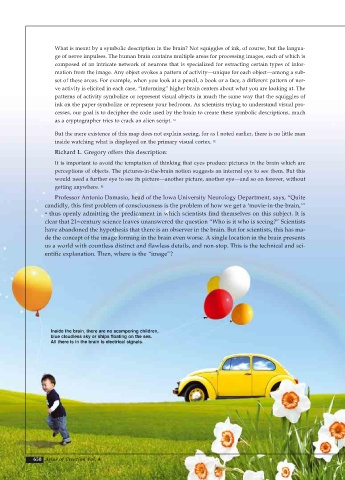Page 660 - Atlas of Creation Volume 4
P. 660
What is meant by a symbolic description in the brain? Not squiggles of ink, of course, but the langua-
ge of nerve impulses. The human brain contains multiple areas for processing images, each of which is
composed of an intricate network of neurons that is specialized for extracting certain types of infor-
mation from the image. Any object evokes a pattern of activity—unique for each object—among a sub-
set of these areas. For example, when you look at a pencil, a book or a face, a different pattern of ner-
ve activity is elicited in each case, “informing” higher brain centers about what you are looking at. The
patterns of activity symbolize or represent visual objects in much the same way that the squiggles of
ink on the paper symbolize or represent your bedroom. As scientists trying to understand visual pro-
cesses, our goal is to decipher the code used by the brain to create these symbolic descriptions, much
as a cryptographer tries to crack an alien script. 51
But the mere existence of this map does not explain seeing, for as I noted earlier, there is no little man
inside watching what is displayed on the primary visual cortex. 52
Richard L. Gregory offers this description:
It is important to avoid the temptation of thinking that eyes produce pictures in the brain which are
perceptions of objects. The pictures-in-the-brain notion suggests an internal eye to see them. But this
would need a further eye to see its picture—another picture, another eye—and so on forever, without
getting anywhere. 53
Professor Antonio Damasio, head of the Iowa University Neurology Department, says, “Quite
candidly, this first problem of consciousness is the problem of how we get a ‘movie-in-the-brain,’”
54 thus openly admitting the predicament in which scientists find themselves on this subject. It is
clear that 21 -century science leaves unanswered the question “Who is it who is seeing?” Scientists
st
have abandoned the hypothesis that there is an observer in the brain. But for scientists, this has ma-
de the concept of the image forming in the brain even worse. A single location in the brain presents
us a world with countless distinct and flawless details, and non-stop. This is the technical and sci-
entific explanation. Then, where is the “image”?
Inside the brain, there are no scampering children,
blue cloudless sky or ships floating on the sea.
All there is in the brain is electrical signals.
658 Atlas of Creation Vol. 4

